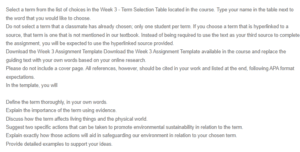Sustainable Living Guide Contributions – Sustaining our Water Resources
The Great Pacific Garbage Patch
The Great Pacific Garbage Patch is an area in the North Pacific Ocean where marine debris (such as plastic) is concentrated. A garbage patch is where floating waste accumulates in the middle of large rotating current systems known as gyres that define surface movement patterns in universal oceans. The waste materials are not moved through human activities but by wind and water currents and accumulate far from land. Plastics are so common and durable; therefore, they make up the main waste materials in garbage patches. Plastics include polymers that are non-biodegradable as they are made up of strong or unfamiliar bonds that cannot be broken down by living organisms (Kim, 2014). Therefore, The Great Pacific Garbage Patch is an important matter as it poses risks to aquatic life, the environment, and human health.
The Great Pacific Garbage Patch poses multiple threats through the entanglement of marine life caught by items like fishing nets and the ingestion of waste materials. Entanglement by marine wastes may wound the aquatic animals or lead to skin lesions and ulcerated sores. Ingestion of wastes causes blockage of the digestive system resulting in satiation, starvation, debilitation, and death (Harse, 2011). Also, some of these materials contain carcinogenic toxins like mercury that may be ingested by fish and, therefore, human beings. Aesthetically, marine debris tends to accumulate on beach lines, interfering with the natural beauty of these scenes. Finally, marine wastes may be a route for introducing invasive species. They may provide suitable habitats for invasive marine larvae that threaten aquatic life.
Environmental sustainability can be promoted through reduction and preventive measures. These include the use of biodegradable processes to eliminate plastic waste. For example, organisms like the pestalotiopsis, an endophytic fungus that degrades polyurethane in its solid and liquid form, can be utilized to eliminate polyesters. Informing people about the effects of the garbage patch will also encourage better human practices, such as the designation of bins for the proper disposal of waste. Further, preventive measures may include joining Boyan Slat’s revolution about cleaning the ocean. Slat designed the ‘long floating curtains’, a safe method for effectively removing waste materials without harming marine life. This system can remove approximately 98% of waste, hence preventing pollution of the water systems (Barnhart et al., 2017).
References
Barnhart, A., Bisong, L., Brittenham, M., & Eccher, E. (2017). The Great Pacific Garbage Patch. Digitalcommons.cedarville.edu. Retrieved 14 February 2022, from https://digitalcommons.cedarville.edu/cgi/viewcontent.cgi?article=1018&context=public_health_posters.
Harse, G. (2011). Plastic, the Great Pacific Garbage Patch, and International Misfires at a Cure. UCLA Journal of Environmental Law and Policy, 29(2), 336-338. https://doi.org/10.5070/l5292019968
Kim, D. (2014). Gyre Plastic: Science, Circulation and the Matter of the Great Pacific Garbage Patch. Retrieved 14 February 2022, from https://www.proquest.com/openview/ab7b71d7449c5749a86b2bf3045a70f5/1?pq-origsite=gscholar&cbl=18750.
ORDER A PLAGIARISM-FREE PAPER HERE
We’ll write everything from scratch
Question

Sustainable Living Guide Contributions
Select a term from the list of choices in the Week 3 – Term Selection Table located in the course. Type your name in the table next to the word that you would like to choose.
Do not select a term that a classmate has already chosen; only one student per term. If you choose a term that is hyperlinked to a source, that term is one that is not mentioned in our textbook. Instead of being required to use the text as your third source to complete the assignment, you will be expected to use the hyperlinked source provided.
Download the Week 3 Assignment Template, available in the course, and replace the guiding text with your own words based on your online research.
Please do not include a cover page. All references, however, should be cited in your work and listed at the end, following APA format expectations.
In the template, you will
Define the term thoroughly, in your own words.
Explain the importance of the term using evidence.
Discuss how the term affects living things and the physical world.
Suggest two specific actions that can be taken to promote environmental sustainability in relation to the term.
Explain exactly how those actions will aid in safeguarding our environment in relation to your chosen term.
Provide detailed examples to support your ideas.

